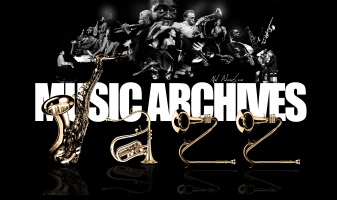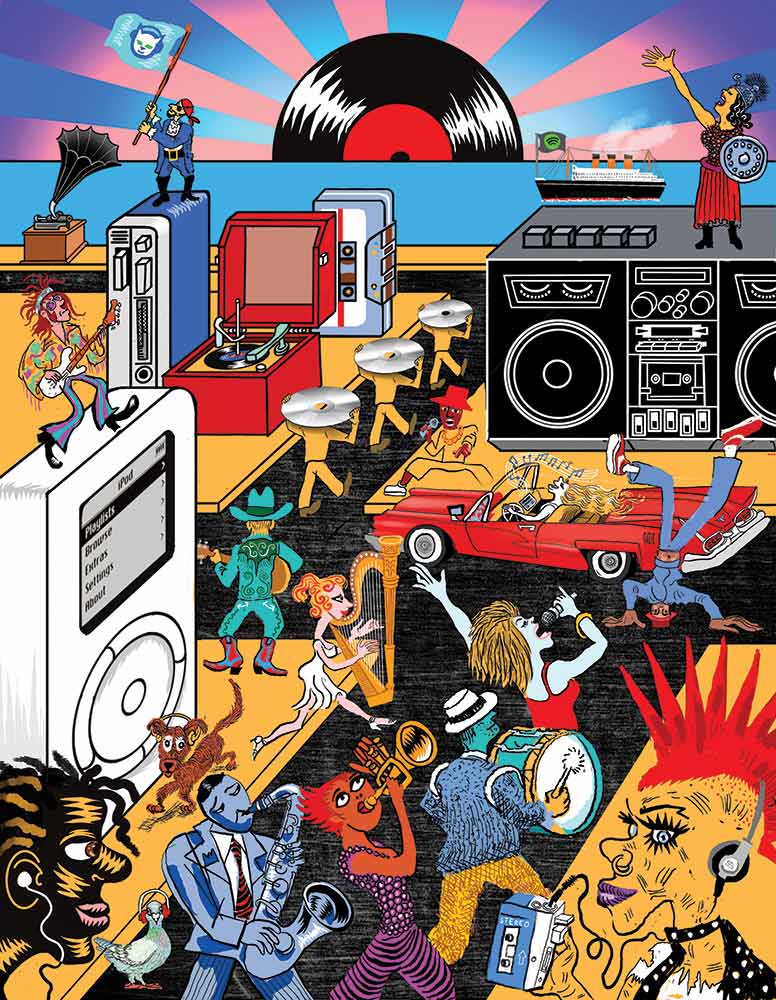
 |
The End of the Music Business By Ethan Iverson |
Post Reply 
|
| Author | |
snobb 
Forum Admin Group 

Site Admin Joined: 22 Dec 2010 Location: Vilnius Status: Offline Points: 29386 |
 Post Options Post Options
 Thanks(0) Thanks(0)
 Quote Quote  Reply Reply
 Topic: The End of the Music Business By Ethan Iverson Topic: The End of the Music Business By Ethan IversonPosted: 11 Apr 2023 at 11:07am |
The End of the Music BusinessA century of recorded music has culminated in the infinite archive of streaming platforms. But is it really better for listeners?By Ethan Iverson Illustration by Josh Gosfield. In 1902, Thomas Edison’s wax cylinder was finally sturdy enough to be sold in bulk, and Americans started buying recordings of music for the home phonograph. There was money to be made from this novel idea: Enrico Caruso’s rendition of “Vesti la giubba” from Pagliacci would sell a million copies by the end of 1903. Soon enough, the 78-rpm record, a brittle disc of lacquer with grooves on each side, became the standard. The technology seems primitive—a needle riding a groove without even a basic electric current—but it could be very loud. Ma Rainey recorded a string of important hits in the 1920s, and the Mother of the Blues still has the power to make a weak man change his cheating ways—especially if you hear her sermon blaring out of the old Victrola, its bent bell horn projecting ominously into the room. Those early 78s are short (just three minutes a side), compressed in sonic range (the bass register is notably weak), and garnished by a constant low sizzle like that of a frying steak. The race for improved technology was on. Engineers started using electricity in the late ’20s and magnetic tape in the ’30s, but one postwar development proved to be definitive: the long-playing microgroove vinyl disc, 10 inches in diameter, later expanded to 12 inches, rotating smoothly at 33⅓ revolutions per minute. The key was duration: Up to 45 minutes of music could now stand as a unified statement. A great plateau! Starting in about 1955, countless labels churned out 12-inch records documenting the peaks of human achievement in all genres: classical music, rock and roll, rhythm and blues, everything else. A Beethoven symphony fit on an LP; so did a songbook recital by Ella Fitzgerald or a concept album by the Beatles. For modern jazz, the classic LP is the basic text and the organizing principle of the genre, the universal and internal standard by which to judge excellence. An LP was pricey, though, so the more popular purchase in those years was the cheaper 45, an update of the 78 with two short sides, each yearning to be a hit. In the late ’60s, the record industry tried out 8-track and cassette tapes; both were especially good for cars and trucks, and later the cassette was found in boom boxes and Walkmans. Still, the item that pulled the most weight was the LP, which was not only a delivery system for the sounds but also a perfect accessory for the accompanying lifestyle. After dropping stylus on platter, one could sit back and examine the sizable LP jacket with its cover art, liner notes, and technical information, or else carefully reorder one’s collection according to name, genre, label, or spine color. This more than 30-year run of LP excellence and commercial success reached an apotheosis in 1982 with Michael Jackson’s Thriller, which Sony claims has sold more than 100 million copies worldwide, making it one of the best-selling albums of all time. A few years later, the LP was seemingly rendered nearly obsolete by the compact disc. Invented in 1979 but not widely seen until 1985, the expensive and supposedly sonically superior CD, initially sold in bulky and wasteful packaging to discourage shoplifting, made steady inroads into vinyl’s dominance. The music business had already made serious money with the LP, but the CD expanded its profits to astronomical levels. Everyone suddenly agreed not just to buy newly released music on CD but to replace all their vinyl as well. For 10 or 15 years, fancy boxed sets of favored legacy artists were highly prized Christmas presents. In 1999, a particularly good year, record companies raked in $25.6 billion, in 2023 dollars. Few realized it at the time, but the seeds of the industry’s collapse were contained in the digital underpinning of the new format. CDs are rendered in the binary logic of 0s and 1s, just like computer code, and this modality makes for easy replication. The peak of CD buying came a century after the first mass-produced wax cylinder. This coincided with the rise of personal computers equipped with a CD drive and an MP3 application like iTunes. Recordable CDs had been around a while, but now anyone could rip, and burn, the music on their expensive CDs with no loss of sound quality and share it with others. Game over. My own career as a musician was launched right at that moment. My jazz trio the Bad Plus signed to Columbia Records in 2002, and our debut disc, These Are the Vistas, sold 100,000 copies in the United States alone. (This was a surprisingly large number for an avant-garde instrumental outfit, and probably a matter of luck as much as anything else.) In retrospect, this was the last gasp of the old system; fans told us they burned our 2004 sophomore effort, Give, for their friends. Seemingly overnight, and perhaps for the first time ever, record companies were making substantially less money. Panicked, Columbia attached copyright software, known as XCP, to a raft of 2005 releases, including our third album, Suspicious Activity? Unfortunately, the software contained a digital back door that could be exploited by nefarious hackers. Grimly, we told our fans not to buy our record until this digital rights violation was sorted out, and our contract with Columbia expired. Burning CDs was just the beginning of that era’s complete system failure. Binary code had invaded our society via the Internet, and soon file sharing was everywhere, followed by the streaming services. The first culprit, Napster, reared its head in 1999, but the record industry managed to shut it down for copyright infringement in 2001. (The year before, the rock band Metallica had stepped up and sued Napster, taking the hit of attendant bad publicity for suggesting that their fans should actually buy their music.) It wasn’t going to stop with Napster, of course. YouTube started in 2005, the same year Pandora radio exploded; Tower Records, the mainstay brick-and-mortar store for music mavens, folded in 2006. After various arguments, everyone simply gave up and let Spotify enter the American market in 2011. The Manhattan brick-and-mortar chain J&R held on until 2014, but since its final location pulled down the shutters, there hasn’t really been a store in New York City where one could browse all the important new releases in jazz, classical, and pop. If you aren’t online, you’re out of luck. You can’t stop music, but these vicissitudes did stop many nonmusicians from continuing a career in the industry, especially those employed at record companies and record stores. A lot of committed and supportive people were suddenly out of work. Of course, many of the bosses of those companies were titans of an evil empire, especially in genres that commanded top dollar. Countless musicians have been exploited by the system, in some cases making pennies for innovations that have influenced the culture worldwide. Many of us can quote Hunter S. Thompson verbatim: “The music business is a cruel and shallow money trench, a long plastic hallway where thieves and pimps run free, and good men die like dogs. There’s also a negative side.” Consider as urbane a product as the 1959 album Kind of Blue by Miles Davis, generally held to be a flawless masterpiece. The luminous sidemen on Kind of Blue—Cannonball Adderley, John Coltrane, Bill Evans, Paul Chambers, and Jimmy Cobb—were paid union scale for each of the two sessions; since Cobb was a drummer, they tossed him a few extra bucks for cartage. A receipt for the second session lists Cobb’s earnings that day as $66.67. One would think that a musician who was vital to the success of the best-selling jazz album of all time—Cobb’s superb, unique swinging beat is heard on almost every second of Kind of Blue—would not need to spend his sunset years worrying about money, but Cobb had to run a GoFundMe for medical expenses in early 2020, before dying in May of that year. As any entertainment lawyer can explain, there’s no mechanism within existing corporate structures to simply award dollars to those who made the records that turned out to be hits. It’s not a secret. The contract says so in black-and-white. Cobb surely signed the paperwork just like anybody else. Davis himself did OK, being a leader with smart management who would have fought for a proper back-end before the deal was completed. But there are countless others who never saw another dime after the first and final payment. There was a silver lining to the early all-digital era: a glamorous new toy, the iPod. For people serious about curating their collection, that first-generation iPod was almost magical. I spent about a week uploading carefully chosen tracks with exactly the right metadata. All my Thelonious Monk, John Coltrane, and Miles Davis was spread out across upscale CD boxed sets, none of which were actually user-friendly for casual listening. I imported the cream of my collection while re-titling and re-sequencing. My goal was simple: If I got run over by a bus, the still-vibrating iPod clutched in my dead hand would contain my official opinion on the best of the best. Apple had other plans. Not satisfied with the iTunes model (buying tunes for a dollar apiece was popular for only a few years), it entered the streaming game with Apple Music, available on the company’s new juggernaut, the iPhone. First, Apple discontinued the optical drive on its laptops (to rip CDs, one now needs an old-fashioned external drive); then, last year, it quietly discontinued the iPod. Apple wanted all roads to lead to a certain mother ship, and it has essentially made that happen. Everyone I know listens to their music with Airpods connected to Apple Music via iPhone. Since I take music seriously and prefer not to be tethered to an iPhone at all times, I’m still on my iPods. I’ve had six or seven of these beloved things. They break or get lost—one took a flying leap through a closing subway door onto the tracks below—but for me, they are just about perfect. Since I can’t buy them new anymore, I’ve taken to buying and refurbishing used ones when I can, although I can tell my latest MacBook is on the verge of rejecting this antiquated technology. Music streaming has done a lot of good. The old industry was a classic gatekeeper, and only a chosen few got a chance. Now everyone has a shot. One example from my personal files: After I included a delightful track by the Ethiopian nun Emahoy Tsegué-Maryam Guèbrou on a Spotify playlist for The New York Times called “5 Minutes That Will Make You Love Piano,” notes poured in from everywhere, including from fashion designer Isaac Mizrahi and artist Christoph Niemann. I’m not the only one who has been talking up Guèbrou in the past decade, and our push has apparently succeeded: I’ve heard Guèbrou in restaurants, in airports, and in the Netflix adaptation of the novel Passing. Guèbrou died this year at 99; I hope her late-in-life renaissance has secured her legacy. At any rate, it makes a difference that Guèbrou is only a click away on the streaming services. (In general, a good way to feel heartened about streaming is to look up formerly obscure music on YouTube and find that it has many views, with commenters thrilled to discover a hidden gem.) No one outside of the inner corporate circles really knows how the economics of the streaming world works. It pays, but what does it pay, and to whom? Reasonably high-profile artists in many genres have not been shy about posting their meager Spotify royalty checks to social media. Many of those artists then encourage listeners to buy their music on Bandcamp as a moral choice. That’s when you know the old model is truly dead: “Buy my music as a moral choice.” The music business as we knew it lasted about a century, from 1903 to 2003. Personally, I worry about the metadata. When you bought an LP, you more or less had to take in some text, especially liner notes for jazz and classical records. In a CD package, the print was smaller, sometimes too small to read, but at least it was there. Streaming has almost no text. Yes, one can look it up online, but I still think something is being lost. In jazz, it is of vital importance to know who completes the band. Over the past seven years, many of my jazz students at the New England Conservatory of Music have had no idea who is playing bass and drums on the albums they are streaming. Muzak was conceived by Maj. Gen. George Owen Squier—a prolific inventor whose other credits include telephone multiplexing and the US Air Force. Squier guessed, apparently correctly, that many people wanted to be surrounded by innocuous music more or less all the time. However, Muzak was a specific business model for a certain market, requiring oversight and investment by the purchaser. Spotify has refined that process further, with mood-music playlists to suit any occasion that anybody can access at any time, sometimes generated by algorithm. The coffee shop next to my laundromat in Brooklyn uses jazz for its background music. All my friends and associates know that I am good in a “blindfold test”—in other words, I can recognize jazz albums and personnel from a cold start without being given any information. But in this coffee shop, I can’t recognize the jazz. It is the work of anonymous Scandinavian musicians playing in a deliberately bland style for Spotify playlists, which the streaming giant uses to shave even more pennies from the already tiny checks they send to serious artists. According to the music-recognition app Shazam, the faceless rendition of “Georgia on My Mind” I heard yesterday by the Nouveau Jazz Trio has been streamed millions of times, possibly thanks to its presence on Spotify playlists like “Jazz for Study” and “Lazy Jazz Cat.” When I consider the Nouveau Jazz Trio, I feel the same shiver down my spine that writers feel when they consider ChatGPT. Enough money is being made by streaming for some to claim that the music industry is “back” from the nadir of the late 2000s. Others note that Apple Music is simply a loss leader for the company and that Spotify has yet to turn a profit. I’ve heard that new pop artists actively seek endorsement deals to advertise nonmusical products as soon as they’ve acquired management who can ask around on their behalf. Does video game music actually pay? Can we get a gig on Fortnite? We are a long way from understanding the ramifications of having it all available at the click of a button. Still, music will survive. After all, there was plenty of music before Caruso sold a million records in 1903. If the music industry only lasted a century, so be it. It’s up to the musicians to make the music, no matter what. As a counterweight to streaming, the LP has enjoyed an amazing resurgence. Last year, some 43.5 million LPs were sold in America. When I switched from LP to CD in the late ’80s, I thought for sure that was that. But people like buying vinyl—they like the size, they like the sound, they like taking care of something that degrades. It’s not a moral choice, but a fun one. For all my solo releases in the past decade, the first question from my fans on the socials is always the same: “Are you putting it out on vinyl?” The LP’s return does give me hope for unlikely wins in the future. Reportedly, even the lowly cassette tape is back in favor with listeners who prefer a lo-fi or punk aesthetic. Who knows? Maybe Apple will even reintroduce the iPod. |
|
 |
|
Post Reply 
|
|
|
Tweet
|
| Forum Jump | Forum Permissions  You cannot post new topics in this forum You cannot reply to topics in this forum You cannot delete your posts in this forum You cannot edit your posts in this forum You cannot create polls in this forum You cannot vote in polls in this forum |